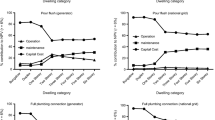Abstract
Water-harvesting structures have the potential to increase the productivity of arable lands by enhancing crop yields and by reducingthe risk of crop failure in arid and semi-arid regions, where water shortages are common because of scanty rainfall and its uneven distribution. In semi-arid regions of Rajasthan, India, existing practice of harvesting rainwater is through anicut and earthen embankments. Because of higher costs and higher technical skills involved in the construction of these structures, these structures have not been accepted by the resource-poor local people. Therefore, in the present paper, the detailed design of some low-cost water-harvesting structures using locally available materials and adaptable to the socio-economic conditions of the beneficiaries is discussed. Two types of cost-effective water-harvesting structures, which include dry stone masonry and upstream-wall cement masonry of heights 1, 2, and 2.5 m for catchments of less than 10, 10 to 20, and 20 to 30 ha, respectively are proposed and designed. The analysis of costs involved in constructing dry stone masonry and upstream-wall cement masonry water-harvesting structures, emergency spillway, anicuts and earthen embankments revealed that the earthen embankments have the least cost of construction whereas the anicuts have the highest construction costs for all the selected heights. However, based on the past experiences, earthen embankments are not suitable for the semi-arid regions of Rajasthan. The economic evaluation of the proposed structures indicated that the dry stone masonry structures are very cost-effective for the region with a benefit-cost ratio of 3.5:1 and the net present worth value of Rs. 102978. Although the economic indicators ranked the upstream-wall cement masonry structures lower than the dry stone masonry structures, the former has greater stability and strength compared to the latter. In practice, both the cost-effective water-harvesting structures (i.e., dry stone masonry and upstream-wall cement masonry) are gaining wide acceptance and popularity in the region through some nongovernmental organizations, which have adopted the design presented in this paper.
Similar content being viewed by others
References
Agarwal, A.: 1998, 'Rainwater harvesting in a new age: When modern groundwater and river exploitation has reached its limits', Water Harvesting, SIWI Paper 2, Stockholm, pp. 5-12.
Bazza, M. and Tayya, M.: 1994, 'Operation and management of water harvesting techniques', in 'Water Harvesting for Improved Agricultural Production', Proceedings of the FAO Expert Consultation, Cairo, Egypt, Nov. 1993, Rome, Italy.
Brooks, K. N., Ffolliott, P. F., Gregersen, H. M. and DeBano, L. F.: 1998, Hydrology and the Management of Watersheds, Panima Publishing Corporation, New Delhi, 502 pp.
CFA: 1997, Comprehensive Assessment of the Freshwater Resources of the World, WMO, Geneva, 33 pp.
Critchley, W. and Siegert, C.: 1991, Water Harvesting Manual, FAO Paper AGL/MISC/17/91, FAO, Rome.
Dijk, J. A. van and Ahmed, M. H.: 1993, 'Opportunities for expanding water harvesting in Sub-Saharan Africa: The case of the Teras of Kassala', Gatekeeper Series No. 40, London, UK: International Institute for Environment and Development.
Dixon, J. and Hufschmidt (eds): 1986, Economic Valuation Techniques for the Environment: A Case Study Workbook, Baltimore: Johns Hopkins Univ. Press.
GOR: 2000, Water Resources Vision 2045, Department of Irrigation, Government of Rajasthan. http://www.rajirrigation.com/vision.htm (accessed on 2 Nov. 2002).
Haan, C. T., Barfield, B. J. and Hayes, J. C.: 1994, Design Hydrology and Sedimentology for Small Catchments, Academic Press, Inc., San Diego, California: 63-103.
Klingebiel, A. A. and Montgomery, P. H.: 1961, Land Capability Classification, Agriculture Handbook No. 210. Soil Conservation Service, U. S. Department of Agriculture, Washington, D.C.
Kolarkar, A. S., Murthy, K. N. K. and Singh, N.: 1983, 'Khadin-A method for harvesting water', J. Arid Environ. 6, 59-66.
Kolavalli, S. and Whitaker, M. L.: 1996, 'Institutional aspects of water harvesting: Khadins in western Rajasthan, India', Paper presented at the 6th Annual Conference of the International Association for the Study of Common Property, June 1996, Berkeley, California, U.S.A.
Kuylenstierna, J. L., Bjorklund, G. and Najlis, P.: 1997, 'Sustainable water future with global implications: everyone's responsibility', Natural Res. Forum 21(3), 181-190.
Nirmale, V. H. and Metar, S. Y.: 2003, Indigenous Knowledge: Wealth of Nation,EmploymentNews, New Delhi, India, 28(10), pp. 1.
Prinz, D.: 1994, 'Water harvesting-past and future', in L. S. Pereira (ed.), Sustainability of Irrigated Agriculture, Proceedings of the NATO Advanced Research Workshop Vimeiro, March 1994, Rotterdam: Balkema.
Prinz, D.: 1996, 'Water Harvesting-History, techniques, trends', Z. f. Bewaesserungswirtschaft 31(1): 64-105.
Prinz, D. and Singh, A. K.: 2003, Technological Potential for Improvements of Water Harvesting, http://www.damsreport.org/docs/kbase/contrib/opt158.pdf (accessed on 5 July 2003).
Renner, H. F. and Frasier, G.: 1995, 'Microcatchment water harvesting for agricultural production. Part 2, Socio-economic considerations', Rangelands 17, 79-82.
Samra, J. S., Sharda, V. N. and Sikka, A. K.: 2002, Water Harvesting and Recycling: Indian Experi-ences, Central Soil and Water Conservation Research & Training Institute, Dehradun, India, 347 pp.
Siegert, K.: 1994, 'Introduction to water harvesting: Some basic principles for planning, design and monitoring', in Water harvesting for improved agricultural production. Proceedings of the FAO Expert Consultation, Cairo, Egypt, Nov. 1993, Rome, Italy.
Singh, G., Venkataramanan, C. and Sastry, G.: 1981, Manual of Soil and Water Conservation. Practices in India, Central Soil and Water Conservation Research & Training Institute (ICAR), Dehradun.
Singh, P. K.: 2000, Watershed Management: Design and Practices, E-media Publications, Udaipur, 174 pp.
Subramanya, K.: 1994, Engineering Hydrology, Tata McGraw-Hill Publishing Company Limited, New Delhi, India, 390 pp.
Tsakiris, G.: 1991, 'Micro-catchment water harvesting in semi-arid regions: Basic design considera-tions', Water Res. Manage. 5, 85-92.
UNEP: 1983, Rain and Storm Water Harvesting in Rural Areas, United Nations Environment Program Dublin: Tycooly International Publishing Limited.
Author information
Authors and Affiliations
Corresponding author
Rights and permissions
About this article
Cite this article
Machiwal, D., Jha, M.K., Singh, P.K. et al. Planning and Design of Cost-effective Water Harvesting Structures for Efficient Utilization of Scarce Water Resources in Semi-arid Regions of Rajasthan, India. Water Resources Management 18, 219–235 (2004). https://doi.org/10.1023/B:WARM.0000043152.86425.7b
Issue Date:
DOI: https://doi.org/10.1023/B:WARM.0000043152.86425.7b




